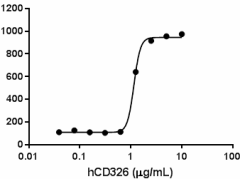- Regulatory Status
- RUO
- Other Names
- Cluster of differentiation 326, Epithelial cell adhesion molecule, Adenocarcinoma-associated antigen, Cell surface glycoprotein Trop-1, TROP1, Epithelial glycoprotein, EGP, Epithelial glycoprotein 314, EGP314, KS 1/4 antigen, KSA

-

Recombinant human CD326/EPCAM supports the adhesion of L929 cells in a dose dependent manner. ED50 for this effect is 0.4 - 1.6 µg/mL. Calcein-AM (Cat. No. 425201) was used to measure the number of adherent cells. -

Stability testing for recombinant human CD326/EPCAM. Recombinant human CD326/EPCAM was aliquoted in PBS, pH 7.2 at 0.2 mg/mL. One aliquot was frozen and thawed four times (4x freeze/thaws), and compared to a control kept at 4°C (control). The samples were tested in an adhesion assay with L929 cells.
| Cat # | Size | Price | Quantity Check Availability | ||
|---|---|---|---|---|---|
| 777302 | 10 µg | $89.00 | |||
| 777304 | 25 µg | $194.00 | |||
| 777306 | 100 µg | $511.00 | |||
Select size of product is eligible for a 40% discount! Promotion valid until December 31, 2024. Exclusions apply. To view full promotion terms and conditions or to contact your local BioLegend representative to receive a quote, visit our webpage.
EPCAM is a type I transmembrane protein, composed of thyroglobulin type I domain on the extracellular domain, a transmembrane region and a 26-amino acid intracellular region. EPCAM is expressed in epithelial tissues, but it cannot be detected in normal squamous epithelia except carcinoma. In mice, the homolog of human EPCAM has been found in thymic epithelial cells, thymocytes, T cells and dendritic cells. The expression level of EPCAM differs among tissues, but it is higher in proliferating cells than in differentiated cells. Several studies demonstrated that EPCAM is involved in cell adhesion, proliferation, migration and gene expression. EPCAM mediates homophilic cell-cell adhesions in Ca2+-independent manner. Its N-terminal domain is necessary for adhesion. In addition, EPCAM serves as a diagnostic biomarker of cancer. High level of EPCAM is found in several carcinoma and correlates with tumor progression in cervical neoplasia and survival in breast cancer patients. EPCAM associates with the tight junction protein claudin 7, resulting in tumor growth, metastasis formation and apoptotic resistance. EPCAM undergoes intramembrane proteolysis, catalyzed by TNF-α converting enzyme (TACE) and presenilin-2 (PS-2/γ-secretase), which in turn produces the extracellular (EpEX) and intracellular (EpICD) domains of EPCAM. EpICD forms a nuclear complex with β-catenin, its co-activator FHL2 and Lef-1. It has been indicated that EPCAM upregulates oncogenic transcriptional factor c-myc and cell cycle-related proteins Cyclin A/E. Furthermore, EPCAM can induce expression of reprogramming factors, including OCT4, SOX2 and NANOG. EPCAM is a potential target in cancer therapy. Antibodies against EPCAM and vaccine-based clinical trials in different carcinoma have been conducted.
Product Details
- Source
- Human EPCAM, amino acid Gln24-Lys265 (Accession # P16422), with 6His tag, was expressed in 293E cells.
- Molecular Mass
- The 248 amino acid recombinant protein has a predicted molecular mass of approximately 28.2 kD. The DTT-reduced and non-reduced protein migrates at approximately 36.5 kD respectively by SDS-PAGE. The predicted N-terminal amino acid is Gln.
- Purity
- > 95%, as determined by Coomassie stained SDS-PAGE.
- Formulation
- 0.22 μm filtered protein solution is in PBS, pH 7.2
- Concentration
- 10 and 25 µg sizes are bottled at 200 µg/mL. 100 µg size and larger sizes are lot-specific and bottled at the concentration indicated on the vial. To obtain lot-specific concentration and expiration, please enter the lot number in our Certificate of Analysis online tool.
- Storage & Handling
- Unopened vial can be stored between 2°C and 8°C for up to 2 weeks, at -20°C for up to six months, or at -70°C or colder until the expiration date. For maximum results, quick spin vial prior to opening. The protein can be aliquoted and stored at -20°C or colder. Stock solutions can also be prepared at 50 - 100 µg/mL in appropriate sterile buffer, carrier protein such as 0.2 - 1% BSA or HSA can be added when preparing the stock solution. Aliquots can be stored between 2°C and 8°C for up to one week and stored at -20°C or colder for up to 3 months. Avoid repeated freeze/thaw cycles.
- Application
-
Bioassay
- Application Notes
-
BioLegend carrier-free recombinant proteins provided in liquid format are shipped on blue ice. Our comparison testing data indicates that when handled and stored as recommended, the liquid format has equal or better stability and shelf-life compared to commercially available lyophilized proteins after reconstitution. Our liquid proteins are verified in-house to maintain activity after shipping on blue ice and are backed by our 100% satisfaction guarantee. If you have any concerns, contact us at tech@biolegend.com.
-
Application References
(PubMed link indicates BioLegend citation) -
- Balzar M, et al. 2001. Mol. Cell. Biol. 21:2570.
- Nelson AJ, et al. 1996. Eur. J. Immunol. 26:401.
- Schnell U, et al. 2013. Biochim. Biophys. Acta. 8:1989.
- Nübel T, et al. 2009. Mol. Cancer Res. 7:285.
- Münz M, et al. 2004. Oncogene 23:5748.
- Philip R, et al. 2015. Oncotarget. 6:2046.
- Maetzel D, et al. 2009. Nat. Cell. Biol. 11:162.
- Armstrong A, Eck SL. 2003. Cancer Biol. Ther. 2:320.
- Lin CW, et al. 2012. J. Biol. Chem. 287:39449.
Antigen Details
- Structure
- Monomer
- Distribution
-
Undifferentiated embryonic stem cells, epithelial cells, adenocarcinoma; Plasma membrane
- Function
- EPCAM mediates Ca2+-independent homophilic intercellular adhesion and it is involved in tumor progression.
- Interaction
- Claudin 7, β-catenin, FHL2
- Ligand/Receptor
- EPCAM
- Bioactivity
- Measured by its ability to support the adhesion of L929 cells
- Biology Area
- Cell Biology, Immunology, Stem Cells
- Molecular Family
- Adhesion Molecules, CD Molecules
- Gene ID
- 4072 View all products for this Gene ID
- UniProt
- View information about CD326 on UniProt.org
